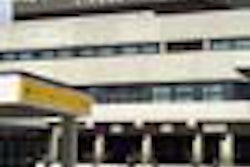Clinical features--Patients with idiopathic pulmonary fibrosis (IPF) are typically aged 50 to 70 years, and men are more commonly affected than women.1, 2, 10 Typical symptoms include dry cough and dyspnea on exertion. Physical exam may reveal "velcro-type" inspiratory crackles, and digital clubbing may be found in 25% to 50% of cases. Chest pain and hemoptysis are uncommon. Laboratory investigations are generally unrevealing. Pulmonary function tests (PFTs) commonly reveal a restrictive defect, with decreased total lung capacity, functional residual capacity, and residual volume.1, 2, 10 The diffusing capacity of carbon monoxide (DLCO) is commonly reduced as well. Overall survival is poor, with a 30% to 50% 5-year survival rate. Treatment is often ineffective (<10% of patients will respond), and generally relies on the use of corticosteroids and immunosuppressive/cytotoxic agents. Single lung transplantation may be considered in selected patients.
Radiographic findings--Chest radiographs: Plain chest radiographs typically show decreased lung volumes and bilateral, basilar and subpleural predominant reticulation and honeycombing (figure 1 -- 34KB).1, 2, 10, 11 Serial radiographs are particularly helpful in revealing slowly diminishing lung volumes over time.2 A ground glass appearance is uncommonly encountered, but is also typically basilar in distribution.10 Small nodules are uncommonly seen, and radiographs are normal in less than 10% to 15% of cases.2, 12-14 The severity of findings on the plain chest radiograph correlates poorly with the clinical functional status.10
HRCT: HRCT commonly reveals patchy, basilar and subpleural irregular linear opacities (intralobular, interstitial thickening), characteristically associated with traction bronchiectasis and honeycombing (figure 2 -- 55KB).1-3, 10, 15 Ground glass opacity may be encountered, and presumably reflects alveolitis and may indicate treatable disease.16, 17 However, ground glass opacity has been shown to correlate with alveolar septal granulation tissue and fibrosis histologically, raising the possibility that ground glass opacity may actually reflect early lung fibrosis, but not necessarily reversible disease.2, 18 When ground glass opacity is seen among other findings of fibrosis (reticular opacities, traction bronchiectasis, and honeycombing), the ground glass opacity likely represents fibrosis below the limit of resolution of HRCT. Ground glass opacity should be interpreted as potentially treatable disease only when there are no associated HRCT findings of fibrosis.3 Fibrosis initially appears as fine reticular opacities; these reticular opacities become coarser as the disease progresses. Discrete nodules are seen occasionally. Irregular interlobular septal thickening may be present as well. Mild mediastinal lymph node enlargement is common, but lymph node enlargement in >2 cm is rare.10, 19-22
Several studies have shown that CT and HRCT are superior to plain chest radiographs for the assessment of patients with IPF.23-28 For example, honeycombing may be seen in up to 90% of CT studies as compared with 30% of cases on plain radiographs. HRCT findings have been shown to correlate with symptoms and pulmonary function abnormalities in patients with IPF.29, 30
HRCT allows a distinction of active, potentially reversible alveolitis from irreversible fibrosis in the majority of patients with IPF, obviating the need for surgical biopsy in characteristic cases.24, 25, 27, 28, 31 HRCT can be helpful in predicting potential response to treatment and long-term prognosis in patients with IPF.30, 32 HRCT is also useful for directing the optimal site for lung biopsy in difficult cases.33 Generally, biopsy is directed away from regions of obvious honeycombing and toward regions of ground glass opacity.
Next page: Nonspecific interstitial pneumonitis
1 2 3 4 5 6 7 8 9 10 11


















